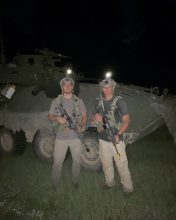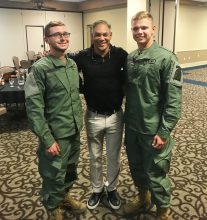By Cadet Michael Hoffmann, Virginia Military Institute
We five ROTC Cadets arrived at the Alexandria Airport in Louisiana, anxious to begin what would prove to be an unforgettable experience. Two officers wearing pressed olive green field uniforms and maroon berets crested low over their eyebrows, the distinctive uniform of the 1st Battalion, 509th Infantry Regiment, soon arrived and took us to Fort Polk.
The 1/509th, or “Geronimo” Battalion, was activated in 1941 and possesses a rich history, including the Army’s first combat jump during World War II in November 1942. Today the 509th serves as the Opposing Force (OPFOR) at the U.S. Army’s Joint Readiness Training Center (JRTC).
I volunteered to spend three weeks with the 509th through a new Army program for rising sophomore and junior ROTC contracted Cadets to gain Army experience and learn about leadership. Our summer assignment to this battalion focused on the upcoming training rotation against the 1st Brigade Combat Team (BCT) “Devils in Baggy Pants” of the 82nd Airborne Division. Like many other units, they consider the 509th “Geronimo” Battalion the “Most Hated Unit in the Army”- a title the 509th wears proudly. These “hated” Soldiers taught me and demonstrated lessons about humility, character, and leadership that shaped my perspective on being an officer and gave me a base of experience and knowledge to apply to my ROTC training.
After being assigned to 1st Platoon, Dog Troop and issued my OG’s, I went into the field to fight the 82nd. 1st Lt. Charles Atkins and Sgt. 1st Class Robert Donahue showed me the ropes by being included in the planning, preparation, and execution of every mission and as well as getting answers to all my never-ending questions.

Cadets Garrett Lyons, (left) and Michael Hoffmann stand in front of the LAV-25 they captured while training with members of the 1st Battalion, 509th Infantry Regiment. They were serving as the Opposing Force (OPFOR) during the unit’s rotation at the U.S. Army’s Joint Readiness Training Center (JRTC). Courtesy photo
Our platoon was tasked with harassing and disrupting the 82nd after they made a forced-entry jump into the Fort Polk drop zone. We did everything possible to disrupt and harass them, including blowing air horns to prevent them from sleeping, constructing road blocks, and stealing their vehicles. In one small engagement on the first day of the rotation, we even managed to steal a LAV-25, an armored reconnaissance vehicle. I was ecstatic about it. I guarantee that if you told my fellow Cadets at the Virginia Military Institute that they could prank the 82nd and steal their tanks over the summer, there would be a line at the sign-up station a mile long.
I must have looked like a kid in a candy store the entire rotation. I was allowed as much ammunition as I could fire, used night vision goggles for the first time, fired a replicated Russian Rocket Propelled Grenade, and was exposed to every piece of equipment that the 82nd brought. M1 Abrams thundered by me while Apache attack helicopters circled overhead. Bradley Infantry Fighting Vehicles (IFV) charged across fields, and up-armored Humvees with mounted anti-tank (TOW) missiles and 50-caliber machine guns were everywhere. I had really lucked out.
Despite the abundance of exciting moments, “hurry-up-and-wait” was a common theme even in the field. However, these slower moments were perhaps the most valuable. Without real rank or position, I used this time to mingle with Soldiers at every level in the Chain of Command, from privates to captains, and asked them what they expected from a Platoon Leader (PL) – what made them good, and what made them bad.
The NCOs were incredibly helpful and took every opportunity to teach me about the Army and being a leader. Their collective advice was best summed by Donahue: be adaptive, be humble, trust your NCOs, learn from them, and ultimately lead them. The relationship between a PL and Platoon Sergeant is a unique one, but every NCO I talked to emphasized the importance of trust, humility, and competence. Often, they would cite Army field manuals and instruct me to read and know them. Learning about NCO roles and responsibilities humbled me and gave me a genuine appreciation for why they are the backbone of the Army.
Privates and specialists, in contrast, emphasized the amount of control that the PL possesses over their lives. Good PLs, in their mind, enabled them to attend schools, looked out for them, and were cognizant of who carried out their orders. Their biggest complaint was being uninformed, which made them feel alienated and useless and gave me an important lesson about unit morale.
The time I spent with these Soldiers my age, listening to their gripes, joking with them, hearing their stories from “the Box,” and even helping them clean the company office were some of the most beneficial experiences of my three weeks. In a few short years, these will be the type of Soldiers I will be responsible for, and lead.

Gen. Michael Garrett (center), Commanding General of Forces Command, poses for a picture with Cadets Luke Weliever (left) and Michael Hoffmann (right). Courtesy photo
In addition to my time with enlisted personnel, the officers of the 509th were particularly interested in developing and mentoring us. Gen. Michael Garrett, Commanding General of Forces Command, took all the Cadets to dinner, and his advice was strikingly similar to everything else we had heard: trust your NCOs, set the standard and be the example, do lots of physical training, and remember that everything you do is to prepare for combat. Above everything else, he emphasized not overcomplicating the job of being a PL. The Army is a people business, he said; be yourself.
Brig. Gen. Patrick Frank, the Commanding General of Fort Polk and JRTC, took us on some grueling (but fun) log PT, and noted that Soldiers are the most perceptive people in the world. Col. David Gardner and Lt. Col. John Moltz, commanders of the Operations Group and the 1-509th Battalion respectively, were extremely open in sharing their thoughts with us about the demands for leading Soldiers, emphasizing the importance of self-discipline and servant-leadership. Maj. Donald Sulpizio, Brig. Gen. Frank’s Operations Officer, stressed intellectual development and left me with a challenge: “deserve to lead.”
We saw all this advice manifested by our company commanders and platoon leaders, who clearly developed a great culture within their formations. My troop commander, Capt. Michael Glass, seemed to embody the advice we were given and impressed me from the moment I met him; he treated everyone with respect and we could see the respect afforded to him in return. In our platoons, we saw many distinctive styles of leadership, and started to understand what would be expected of us in a few short years.
After fighting against the 1st BCT of the 82nd, we shadowed their culminating event: a live-fire exercise involving all their infantry, engineer, armor, and air assets. Cadet Garrett Lyons and I were paired with two NCOs responsible for the safety of the Paratroopers who showed us how good and bad training affected Soldiers’ actions in the heat of battle while continuing to answer our still-never-ending questions. In many ways, it was a culminating event for us Cadets too.
The lessons we learned throughout the experience manifested themselves in the actions, both good and bad, of the Paratroopers we observed under the pressure of live-fire. Virtually none of their rank insignia were visible to us, but it was obvious who took charge and had the respect of the Soldiers. When we couldn’t figure out who was in charge, we witnessed the confusion and simulated casualties that followed. If we hadn’t already been impressed enough by the power that the U.S. Army brings to the battlefield, we watched in awe as the paratroopers employed Javelin and TOW Missiles, machine guns, mortars, a mine-breaching vehicle (MICLIC), Bradley IFV’s, and the overwhelming power of the M1 Abrams.
Prior to this new Army initiative of integrating underclass Cadets into active Army units, only rising seniors were eligible for experiences such as mine, and they had the added responsibility to perform in lieutenant-level leadership positions. Without this responsibility however, I could not only learn from the officers, but was able to interact with the enlisted men like a peer and gained a unique, valuable perspective on the Army and leadership. Additionally, I improved my tactical and technical competence while making great memories alongside the Soldiers of 1/509th, and accomplished all this without any classrooms or a single PowerPoint presentation.
Thank you to everyone that made this program happen, and to every Soldier that helped and mentored me along the way.




